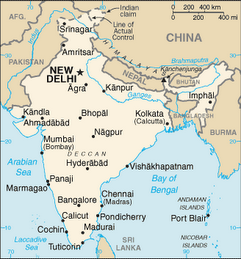 After a typical Monday in Bombay, during which time you span one of the world's largest cities, dine at a fantastic restaurant called Khyber, encounter sadness beyond belief, challenge your originality in the banal ex-pat scene that is modern-day Leopold Cafe, and go out on Marine Drive, I flew home to Delhi at 4am. We had spent an afternoon walking Juhu Beach and stumbling upon a Bollywood model shoot. He had half invaded at the bequest of a mumbling beach-side man who half forced us to the bouncers because of our lighter than tan complexions. Don't worry, Shah Rukh wanted none of us.
After a typical Monday in Bombay, during which time you span one of the world's largest cities, dine at a fantastic restaurant called Khyber, encounter sadness beyond belief, challenge your originality in the banal ex-pat scene that is modern-day Leopold Cafe, and go out on Marine Drive, I flew home to Delhi at 4am. We had spent an afternoon walking Juhu Beach and stumbling upon a Bollywood model shoot. He had half invaded at the bequest of a mumbling beach-side man who half forced us to the bouncers because of our lighter than tan complexions. Don't worry, Shah Rukh wanted none of us.Mid-week we spent ambling through Delhi and the various acronyms that make its scene cooler than it probably should be. Don't get me wrong, Delhi is fun, just not as fun as GK-1 would make it sound. That's a pretty damn cool name, and with rats running in South-Ex II, it's hard to argue that the place is as snazzy as the name. Speaking of rats, they're enormous... ENORMOUS. I giggled in nervousness as each one would dart into and out of street holes toward my feet. Good thing they can cook and they just won an Oscar for their artistry in animation. Hmm...
 Friday's four hour stint at Bollywood blockbuster Jodha Akbar, written in Hindi and Arabic to accentuate the "Great" coming together of the Mughals and Rajputs, left us craving more Rajasthan, more Aishwarya, and well, more Jodhpur... so we boarded an Indian Air flight Saturday morning.
Friday's four hour stint at Bollywood blockbuster Jodha Akbar, written in Hindi and Arabic to accentuate the "Great" coming together of the Mughals and Rajputs, left us craving more Rajasthan, more Aishwarya, and well, more Jodhpur... so we boarded an Indian Air flight Saturday morning.  Jodhpur is the "blue city" due to its ubiquitous indigo paint and ancient 1459 Meherengarh Fort that stands 500m above the town on a massive rampart of rock. Descending from the fantastic palace, as we shuffled to the edge of a rock overlook, I was inclined, and did, burst into song. A whole new world had emerged, and we didn't buy the whole "riff-raff, street rat" gig. Though perhaps the most chaotic city center in India, Jodhpur is alive. It's narrow, it's grimy, it's friendly and intense. It's hundreds of cows, thick black rickshaw puffs, tiny lanes where bodies, animals, bikes, rickshaws, currents of street-side sewage, piles of gravel that tilt your vehicle degrees beyond sanity toward oncoming traffic, abandoned wagons and overturned machinery intwine in perilous moments of intersection where timing tempts the fate of futures and dreams. It is chaos incarnate inside the city walls, but after a few hours you learn the predictability that keeps you safe. You walk decisively. You move with pace and reason. You do not hesitate or you tempt judgement of those whose action may influence your own. Everyone does what they have to, and somehow, in the sheer disaster of it all, it works.
Jodhpur is the "blue city" due to its ubiquitous indigo paint and ancient 1459 Meherengarh Fort that stands 500m above the town on a massive rampart of rock. Descending from the fantastic palace, as we shuffled to the edge of a rock overlook, I was inclined, and did, burst into song. A whole new world had emerged, and we didn't buy the whole "riff-raff, street rat" gig. Though perhaps the most chaotic city center in India, Jodhpur is alive. It's narrow, it's grimy, it's friendly and intense. It's hundreds of cows, thick black rickshaw puffs, tiny lanes where bodies, animals, bikes, rickshaws, currents of street-side sewage, piles of gravel that tilt your vehicle degrees beyond sanity toward oncoming traffic, abandoned wagons and overturned machinery intwine in perilous moments of intersection where timing tempts the fate of futures and dreams. It is chaos incarnate inside the city walls, but after a few hours you learn the predictability that keeps you safe. You walk decisively. You move with pace and reason. You do not hesitate or you tempt judgement of those whose action may influence your own. Everyone does what they have to, and somehow, in the sheer disaster of it all, it works.

















